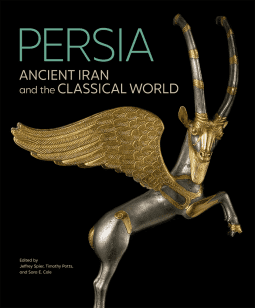As an art history student, I was introduced to Persia from the perspective of Rome and Greece. In the last few years, I’ve noticed and read a number of books telling a broader story, one written with a more balanced view, sharing discoveries from archaeology which add new dimensions about this fascinating period of time. It was with curiosity that I picked up “Persia” having read a well-written narrative on Persia which had no accompanying visuals. As Persians were such an artistic and creative people, with distinct clothes, architecture and symbolism, I eagerly opened this book to see the history rather than just read it.
This book is by no means light on narrative, were you to just read this one, you would understand Persia, it’s rise and fall, it’s lasting influence and it’s idiosyncrasies but, you also get to look at magnificent artworks and read about the meaning and purpose of each. The visuals are large and I found myself examining some of the pieces for several minutes, mesmorised by the intricracies. Being placed geographically where it was, and with the travel the Persians did across the continents, it’s interesting to see influences from other places on the art and visa versa.
It is a beautifully written journey through time with stunning art and sculpture, if you love history and art, do read this one! It’s a five out of five on the enJOYment scale and highly recommended.
I received a complimentary copy of the book from Getty’s Publications through NetGalley. Opinions expressed in this review are completely my own.

From the back cover:
A fascinating study of Persia’s interactions and exchanges of influence with ancient Greece and the Roman Empire.
The founding of the first Persian Empire by the Achaemenid king Cyrus the Great in the sixth century BCE established one of the greatest world powers of antiquity. Extending from the borders of Greece to northern India, Persia was seen by the Greeks as a vastly wealthy and powerful rival and often as an existential threat. When the Macedonian king Alexander the Great finally conquered the Achaemenid Empire in 330 BCE, Greek culture spread throughout the Near East, but local dynasties—first the Parthian (247 BCE–224 CE) and then the Sasanian (224–651 CE)—reestablished themselves. The rise of the Roman Empire as a world power quickly brought it, too, into conflict with Persia, despite the common trade that flowed through their territories.
Persia addresses the political, intellectual, religious, and artistic relations between Persia, Greece, and Rome from the seventh century BCE to the Arab conquest of 651 CE. Essays by international scholars trace interactions and exchanges of influence. With more than three hundred images, this richly illustrated volume features sculpture, jewelry, silver luxury vessels, coins, gems, and inscriptions that reflect the Persian ideology of empire and its impact throughout Persia’s own diverse lands and the Greek and Roman spheres.
This volume is published to accompany an exhibition on view at the J. Paul Getty Museum at the Getty Villa from April 6 to August 8, 2022.

